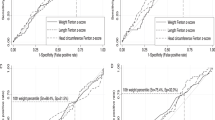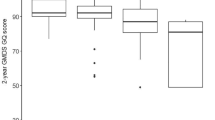Abstract
Objective
To determine the sensitivity and specificity of the 21-month neurodevelopmental outcome for predicting the presence of neurodevelopmental impairment at 36 months corrected age in a population of preterm infants under 29 weeks gestation.
Study design
This is a retrospective observational cohort study. Preterm infants born under 29 weeks gestation who were followed up at both 18–21 months and 36 months corrected age with outcome data available were enrolled.
Results
Overall, 713 preterm infants <29 weeks gestation and were included in the final analysis. The specificity of the 21-month assessment for predicting neurodevelopmental impairment at 36 months corrected age was 66% (95% confidence interval[CI] 62–71%) with a positive predictive value of 61% (95% CI 56–66%).
Conclusion
In preterm neonates born <29 weeks gestation, the 18–21 months corrected neurodevelopmental outcome had low specificity and positive predictive value for predicting the presence of neurodevelopmental impairment at 36 months corrected age.

Similar content being viewed by others
References
Perinatal Health Indicators for Canada 2017. 2017 Available from: https://www.canada.ca/en/public-health/services/injury-prevention/health-surveillance-epidemiology-division/maternal-infant-health/perinatal-health-indicators-2017.html Accessed 16 Jul 2023.
Norman M, Hallberg B, Abrahamsson T, Bjorklund LJ, Domellof M, Farooqi A, et al. Association between year of birth and 1-Year survival among extremely preterm infants in Sweden During 2004-2007 and 2014-2016. JAMA. 2019;321:1188–99.
Santhakumaran S, Statnikov Y, Gray D, Battersby C, Ashby D, Modi N, et al. Survival of very preterm infants admitted to neonatal care in England 2008-2014: time trends and regional variation. Arch Dis Child Fetal Neonatal Ed. 2018;103:F208–F215.
Varga P, Berecz B, Pete B, Kollar T, Magyar Z, Jeager J, et al. Trends in mortality and morbidity in infants under 500 grams birthweight: observations from our Neonatal Intensive Care Unit (NICU). Med Sci Monit. 2018;24:4474–80.
Synnes AR, Lefebvre F, Cake HA. Current status of neonatal follow-up in Canada. Paediatr Child Health. 2006;11:271–4.
Eliasson AC, Holmefur M. The influence of early modified constraint-induced movement therapy training on the longitudinal development of hand function in children with unilateral cerebral palsy. Dev Med Child Neurol. 2015;57:89–94.
Hendson L, Church PT, Banihani R. Follow-up care of the extremely preterm infant after discharge from the neonatal intensive care unit. Paediatr Child Health. 2022;27:359–71.
Follow-up Care of High-Risk Infants. Pediatrics 2004;114:1377–97.
Weisglas-Kuperus N, Baerts W, Smrkovsky M, Sauer PJ. Effects of biological and social factors on the cognitive development of very low birth weight children. Pediatrics. 1993;92:658–65.
Creighton DE, Tang S, Newman J, Hendson L, Sauve R. Establishing Bayley-III cut-off scores at 21 months for predicting low IQ scores at 3 years of age in a preterm cohort. Paediatr Child Health. 2018;23:e163–e169.
Hack M, Taylor HG, Drotar D, Schluchter M, Cartar L, Wilson-Costello D, et al. Poor predictive validity of the Bayley Scales of Infant development for cognitive function of extremely low birth weight children at school age. Pediatrics. 2005;116:333–41.
Martin JH, Chakrabarty S, Friel KM. Harnessing activity-dependent plasticity to repair the damaged corticospinal tract in an animal model of cerebral palsy. Dev Med Child Neurol. 2011;53:9–13.
Bayley N. Bayley scales of infant and toddler development, third edition: technical manual, 3rd ed. Harcourt: San Antonio, TX, 2006.
Wechsler D. WPPSI-III: technical and interpretative manual. The Psychological Corporation. San Antonio, TX.
Palisano R, Rosenbaum P, Walter S, Russell D, Wood E, Galuppi B. Development and reliability of a system to classify gross motor function in children with cerebral palsy. Dev Med Child Neurol. 1997;39:214–23.
Synnes A, Luu TM, Moddemann D, Church P, Lee D, Vincer M, et al. Determinants of developmental outcomes in a very preterm Canadian cohort. Arch Dis Child Fetal Neonatal Ed. 2017;102:F235–F234.
Russman BS, Gage JR. Cerebral palsy. Curr Probl Pediatr. 1989;19:65–111.
Lodha A, Zhu Q, Lee SK, Shah PS, Canadian Neonatal N. Neonatal outcomes of preterm infants in breech presentation according to mode of birth in Canadian NICUs. Postgrad Med J. 2011;87:175–9.
Papile LA, Burstein J, Burstein R, Koffler H. Incidence and evolution of subependymal and intraventricular hemorrhage: a study of infants with birth weights less than 1,500 gm. J Pediatr. 1978;92:529–34.
Shennan AT, Dunn MS, Ohlsson A, Lennox K, Hoskins EM. Abnormal pulmonary outcomes in premature infants: prediction from oxygen requirement in the neonatal period. Pediatrics. 1988;82:527–32.
Bell MJ, Ternberg JL, Feigin RD, Keating JP, Marshall R, Barton L, et al. Neonatal necrotizing enterocolitis. Therapeutic decisions based upon clinical staging. Ann Surg. 1978;187:1–7.
Patz A. New international classification of retinopathy of prematurity. Pediatrics. 1984;74:160–1.
Trevethan R. Sensitivity, specificity, and predictive values: foundations, pliabilities, and pitfalls in research and practice. Front Public Health. 2017;5:307.
Yates R, Treyvaud K, Doyle LW, Ure A, Cheong JLY, Lee KJ, et al. Rates and stability of mental health disorders in children born very preterm at 7 and 13 years. Pediatrics. 2020;145:e20192699.
Novak I, Morgan C, Adde L, Blackman J, Boyd RN, Brunstrom-Hernandez J, et al. Early, accurate diagnosis and early intervention in cerebral palsy: advances in diagnosis and treatment. JAMA Pediatr. 2017;171:897–907.
Spittle A, Orton J, Anderson PJ, Boyd R, Doyle LW. Early developmental intervention programmes provided post hospital discharge to prevent motor and cognitive impairment in preterm infants. Cochrane Database Syst Rev. 2015;2015:CD005495.
Morgan C, Novak I, Dale RC, Guzzetta A, Badawi N. Single blind randomised controlled trial of GAME (Goals - Activity - Motor Enrichment) in infants at high risk of cerebral palsy. Res Dev Disabil. 2016;55:256–67.
Elkamil AI, Andersen GL, Hagglund G, Lamvik T, Skranes J, Vik T. Prevalence of hip dislocation among children with cerebral palsy in regions with and without a surveillance programme: a cross sectional study in Sweden and Norway. BMC Musculoskelet Disord. 2011;12:284.
Hagglund G, Andersson S, Duppe H, Lauge-Pedersen H, Nordmark E, Westbom L. Prevention of dislocation of the hip in children with cerebral palsy. The first ten years of a population-based prevention programme. J Bone Jt Surg Br. 2005;87:95–101.
Scrutton D, Baird G, Smeeton N. Hip dysplasia in bilateral cerebral palsy: incidence and natural history in children aged 18 months to 5 years. Dev Med Child Neurol. 2001;43:586–600.
Novak I, Cusick A, Lannin N. Occupational therapy home programs for cerebral palsy: double-blind, randomized, controlled trial. Pediatrics. 2009;124:e606–614.
Rostami HR, Malamiri RA. Effect of treatment environment on modified constraint-induced movement therapy results in children with spastic hemiplegic cerebral palsy: a randomized controlled trial. Disabil Rehabil. 2012;34:40–44.
Marlow N, Wolke D, Bracewell MA, Samara M, Group EPS. Neurologic and developmental disability at six years of age after extremely preterm birth. N. Engl J Med. 2005;352:9–19.
Lefebvre F, Gagnon MM, Luu TM, Lupien G, Dorval V. In extremely preterm infants, do the movement assessment of Infants and the Alberta Infant Motor Scale predict 18-month outcomes using the Bayley-III? Early Hum Dev. 2016;94:13–17.
Bode MM, D’Eugenio DB, Mettelman BB, Gross SJ. Predictive validity of the Bayley, third edition at 2 years for intelligence quotient at 4 years in preterm infants. J Dev Behav Pediatr. 2014;35:570–5.
Anderson PJ, De Luca CR, Hutchinson E, Roberts G, Doyle LW. Victorian infant collaborative G. underestimation of developmental delay by the new Bayley-III Scale. Arch Pediatr Adolesc Med. 2010;164:352–6.
Acknowledgements
We thank the Department of Pediatrics, Alberta Children’s Hospital and Neonatal Follow-up Clinic program for ongoing research support.
Author information
Authors and Affiliations
Contributions
SMD: Conceptualization, methodology, writing initial manuscript. ST: Methodology, data curation, formal analysis, reviewed final version of the manuscript. HK: Methodology, data curation, reviewed final version of the manuscript. DC: Methodology, data interpretation, reviewed final version of the manuscript. AL: Conceptualization, methodology, supervision, reviewed final version of the manuscript.
Corresponding author
Ethics declarations
Competing interests
The authors declare no competing interests.
Additional information
Publisher’s note Springer Nature remains neutral with regard to jurisdictional claims in published maps and institutional affiliations.
Additional Information Please note that in accordance with the Alberta Health Services Data Disclosure Agreement, we are not able to provide or make available the data for any purpose to a third party without the prior written consent of Alberta Health Services, Calgary, Alberta.
Rights and permissions
Springer Nature or its licensor (e.g. a society or other partner) holds exclusive rights to this article under a publishing agreement with the author(s) or other rightsholder(s); author self-archiving of the accepted manuscript version of this article is solely governed by the terms of such publishing agreement and applicable law.
About this article
Cite this article
Doucette, S.M., Tang, S., Kehler, H. et al. Utility of the 21-month neurodevelopmental outcome for predicting neurodevelopmental impairment at 36 months for preterm infants <29 weeks gestation. J Perinatol 43, 1406–1412 (2023). https://doi.org/10.1038/s41372-023-01777-3
Received:
Revised:
Accepted:
Published:
Issue Date:
DOI: https://doi.org/10.1038/s41372-023-01777-3
- Springer Nature America, Inc.




